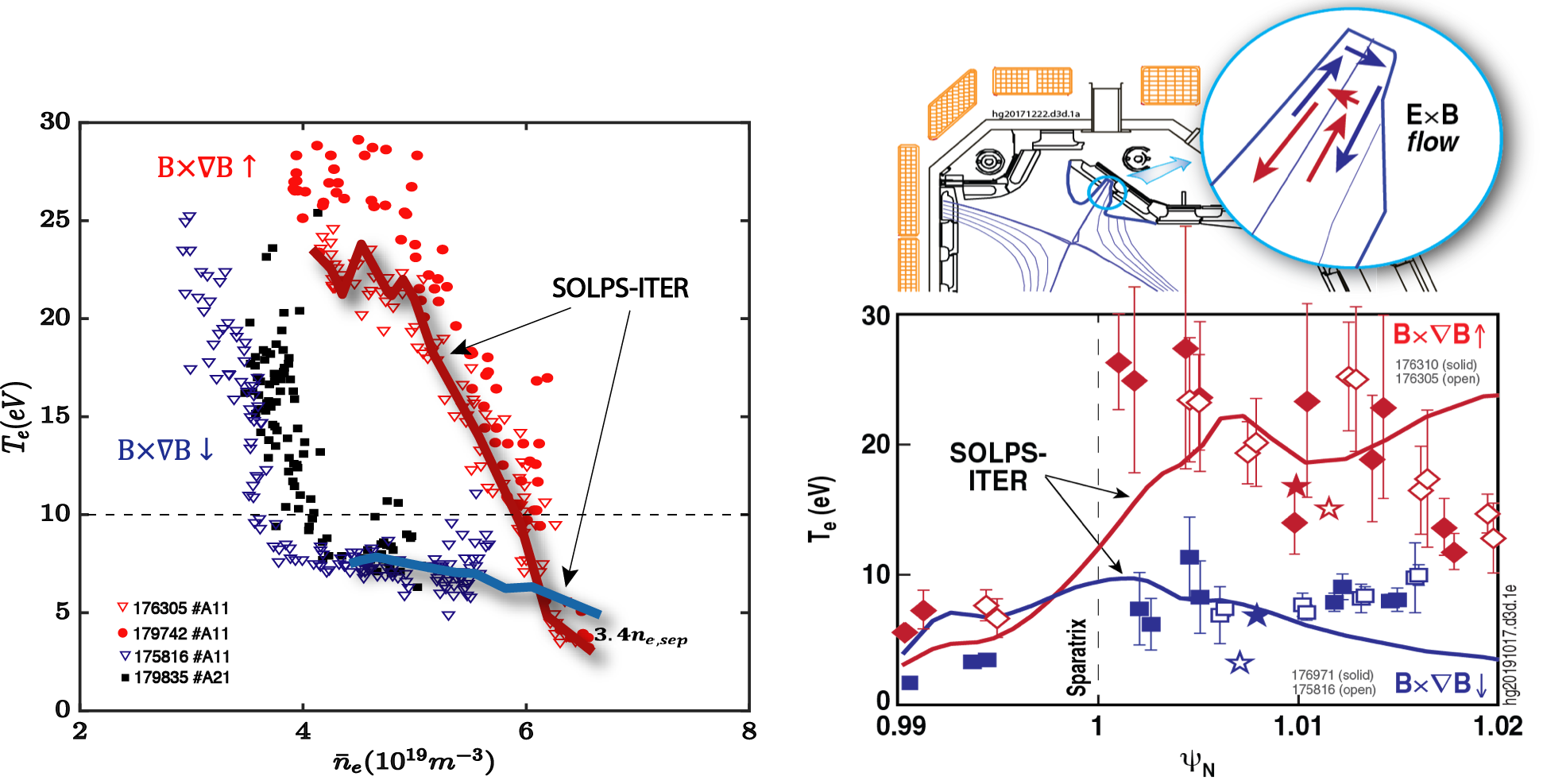Speaker
Description
A small angle slot (SAS) divertor concept 1 with a closed slot structure and appropriate target shaping in the near SOL has been developed in order to explore a potentially robust boundary solution with acceptable plasma surface interaction which is essential for fusion reactor plasma conditions, in particular for high-power steady-state operation. Recent experimental tests in DIII-D have demonstrated the advantages of the SAS divertor over the other divertor geometries on the power dissipation. Compared to either a vertically slanted divertor or a horizontal open divertor, the SAS divertor can strongly cool the plasma at the divertor target over a wider range of H-mode plasma conditions, while the performance of the core plasma is either preserved or the usual deterioration with increasing density is reduced. These benefits are realized by leveraging a strong synergy between the SAS geometry and drifts for ion grad-B drift away from the active divertor, while the effects are much smaller for the opposite $B_T$ direction. This is qualitatively reproduced by SOLPS-ITER simulations which include drifts indicating that, at least for DIII-D scale devices, divertor geometry and drifts have comparable effects on the divertor plasma. This finding is an important step in the understanding of the behavior of advanced divertors for resolution of power exhaust issues.  As can be seen in Fig. 1, experimental results show that for the ion $B \times \nabla B$ drift away from the X-point, a highly dissipative divertor plasma with $Te \leq 10$ eV across the entire SAS divertor target can be achieved at very low main plasma densities. In contrast, for the ion $B \times \nabla B$ drift toward the X-point, the SAS divertor plasma remains hot and attached across the entire divertor target plate until the eventual onset of detachment at significantly higher densities.
As can be seen in Fig. 1, experimental results show that for the ion $B \times \nabla B$ drift away from the X-point, a highly dissipative divertor plasma with $Te \leq 10$ eV across the entire SAS divertor target can be achieved at very low main plasma densities. In contrast, for the ion $B \times \nabla B$ drift toward the X-point, the SAS divertor plasma remains hot and attached across the entire divertor target plate until the eventual onset of detachment at significantly higher densities.
Initial SOLPS-ITER simulations including full $E \times B$ drifts produce similar trends and similar profiles to those observed in experiments. The analysis shows that for the ion $B \times \nabla B$ drift away from the X-point, a strong poloidal $E \times B$ drift moves particles from the inner divertor via the private flux region toward the outer divertor. The drift flow couples synergistically with the geometric effects due to the target shaping predicted in the original SOLPS design modeling without drifts, which strongly enhances neutral momentum and energy dissipation across the divertor SOL. Thus, the SAS divertor can achieve dissipative divertor regime at relatively low densities. However, for the opposite $B_T$ direction, a strong radial $E \times B$ drift moves particle from the outer SOL towards the private flux region and then a poloidal $E \times B$ drift moves particles toward the inner divertor 2. These flows offset the geometric effects of SAS, resulting in a much higher density to achieve detachment.
Experimental data also exhibit the effective cooling of the SAS divertor, compared with other target shaping. Both Langmuir probe measurement and newly installed SETC (surface eroding thermocouple) measurements show that as the strike point is moved across the slot, the peak heat flux drops when the strike point is located near the outer corner (as per the original SAS concept), compared to other strike point locations, i.e., near the inner corner, or on the outboard target in the slot, see Fig. 2. Langmuir probes also show that when the strike point is near the outer corner, the plasma temperature across the measured profile is lower than for other locations. For the ion $B \times \nabla B$ drift toward the X-point, the SETC measurements also show a similar trend that the heat flux is low when the strike point is near the outer corner. This is mainly due to the low particle flux (measured by the divertor Langmuir probes) and is consistent with the simulation, while the plasma temperature remains high until the onset of detachment.
It is notable that a ‘Te cliff’, i.e. Te suddenly drops to below 10 eV for increasing plasma density, is observed for both $B_T$ directions in SAS with the strike point either near the outer corner (Fig. 1) or at the inner slant surface. This is different from the situation for the open divertor where a Te cliff is only observed for the ion $B \times \nabla B$ drift toward the X-point 2. These results also demonstrate a stronger impact of drifts on the dynamics of divertor detachment in a closed slot divertor than in an open divertor.
Furthermore, the SAS divertor with the ion $B \times \nabla B$ drift away from the X-point also improves pedestal performance and core confinement. The confinement collapse associated with the onset of an X-point MARFE occurs at significantly higher pedestal densities for the SAS divertor than for the open divertor in DIII-D, thus widening the window of H-mode operation compatible with a dissipative divertor operation.
This work was supported in part by the US Department of Energy under DE-FC02-04ER54698 and DE-SC0010685.
1 H.Y. Guo et al 2019 Nucl. Fusion 59 086054; 2 A. E. Jaervinen et al 2018 Phys. Rev. Lett. 121, 075001
| Affiliation | General Atomics |
|---|---|
| Country or International Organization | United States |
